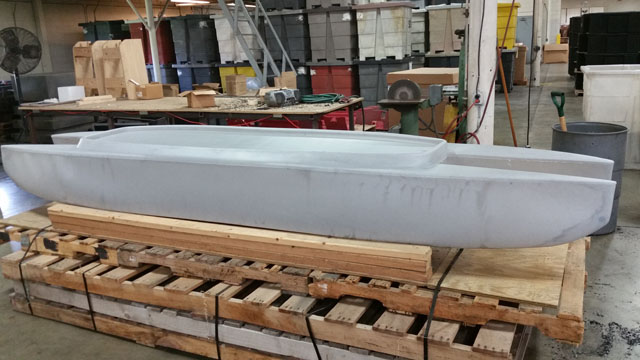This picture was shot at the rotational molding plant, and for us it’s very exciting because it shows the first piece of plastic that came out of the W700 Twinhull mold.
Such object is dubbed ‘part’ in roto-molding lingo.
Our molders made a couple of ‘blank’ parts such as this to clean the new mold from dirt and residue from the Teflon coating, and for use in tests and measurements.
When a ‘part’ is roto-molded it comes out of the mold as one piece without any holes in it. Before a part is outfitted with deck rigging, it is laid in a wooden structure called ‘cooling fixture’, where it keeps cooling down while air is being pressurized in it, in order to prevent uncontrolled cooling that could lead to warping.
After the part is done cooling, the molders cut away its top side, which is the top side of the cockpit, to enable outfitting it with other parts (e.g. saddle, saddle brackets) and accessories, and to allow passengers to enter it. The part seen in this picture still features the top side of the cockpit, and it does not feature the W logo, which is molded into our kayaks.
The color of this blank part is called “natural” and it’s basically colorless. When the molders produce actual W700 kayaks or microskiffs they use polyethylene resin blended with dyes (pigments). The W700 hulls come in Yellow, Dark Green, Sand and White.
This photo doesn’t show the W700 and W500 next to each other, so it doesn’t provide much information on the main difference between these two series, which is size, but it does show the ends of the W700 cockpit’s spray deflector that are vertical and straight. This new design allows for attaching transom motor mounts a few inches closer to the driver. It makes driving easier, and offers the driver better access to the motor’s controls. It also adds a few extra inches the the cockpit’s usable length (92″), and since this boat is designed for two anglers to fish out of, the bigger the distance between them the better.
And for those who missed the 3D animation movie that shows the basic structure of the W700, here it is again:



Here’s a couple more pictures of Twinhull parts after the initial cleaning –